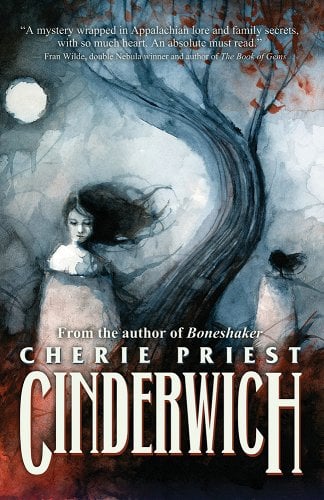
Cherie Priest is joining us today to talk about her novel, Cinderwich. Here’s the publisher’s description:
“Who put Ellen in the blackgum tree?”
Decades after trespassing children spotted the desiccated corpse wedged in the treetop, no one knows the answer.
Kate Thrush and her former college professor, Dr. Judith Kane, travel to Cinderwich, Tennessee in hopes that maybe it was their Ellen: Katie’s lost aunt, Judith’s long-gone lover. But they’re not the only ones to have come here looking for closure. The people of Cinderwich, a town hardly more than a skeleton itself, are staunchly resistant to the outsiders’ questions about Ellen and her killer. And the deeper the two women dig, the more rot they unearth … the closer they come to exhuming the evil that lies, hungering, at the roots of Cinderwich.
What’s Cherie’s favorite bit?

I’ve long and loudly held the opinion that fiction is never half as bizarre as reality – and Cinderwich is a testament to this. It’s also a quiet little mystery in a spooky little town, and let’s be honest…a cozy bit of gothic horror. The stakes are limited, the setting is a character of its own, and the vibes are queer in more than one sense of the word so yes – it checks an awful lot of boxes for a novella of this length. But the mystery at the core was inspired by something that really happened: you see, a long time ago, and a long way away, a woman’s body was found stashed up high in an old tree.
And then it got weird.
Back during the Second World War, four little boys in the rural English countryside went exploring in their neighbor’s woods, against parental orders. They’d soon come to regret the decision, as they spotted upon something funny in a tree overhead, and did a little climbing to get a better look.
Good God, they’d found a body. And they couldn’t tell anyone, or else they’d surely get in trouble. But eventually one of the kids cracked a week or two later and the authorities got involved. The secret was out.
Led by the boys to the tree in question, local law enforcement went on to recover the corpse of a woman about five feet tall, with light curly hair and scraps of taffeta in her mouth, making some wonder if she’d been strangled or suffocated. Whatever happened to her, it’d occurred perhaps two or three years earlier.
No one had the faintest idea who she was. Her remains were sent to the nearest city for examination, and subsequently ended up at a police training center in Birmingham – where they remained unidentified through the 1960s or 1970s, and then…they vanished. Only photographic evidence remained of the woman in the tree.
Sort of.
About a year after the body was found, baffling graffiti appeared around the town. This graffiti appeared on a variety of surfaces over the decades: statues, walls, fences, and so forth. It always spelled out some version of the accusatory message, “Who put Bella down the wych elm?”
Several candidates for “Bella” were put forth over the years, and all were debunked or deemed circumstantial at best. Since the corpse remains unidentified to this day, it’s not even known for certain that the dead woman’s name was even Bella; but then again, there’s no reason to think it wasn’t.
It’s such a sad little footnote to history: this young woman, probably in her early twenties when she died, remained undiscovered for years, and has since then stayed unknown. No one ever claimed her, or stepped forward and said, “Yes, she might have been our daughter, our sister, our friend.” These were the war years, after all. People went missing all the time.
The odds are good we’ll never know who she was, and I could never fix that. But I could take her story and run with it, and that’s what I did – setting it in rural Tennessee, in a small town called Cinderwich.
Interpreting the English true crime case through the lens of an Appalachian gothic was not as tricky as you might expect. I made up a location for my little town (west of the Nickajack Dam in south-central Tennessee), picked a new name (“Ellen”), and a new tree. I probably spent the longest time deciding what tree to use as a repository for my fictional Bella, as we don’t have wych elms/witch elms in the states. After much consideration, I settled on “blackgum,” as it has a similar rhythm to it. The graffiti’s query became, “Who put Ellen in the blackgum tree?”
The rest was easy. The results are cozy, and the novella is something I’m very proud of, for all its quiet strangeness. But I hope you enjoy it that way. Next to the melancholy true crime parts, the quiet strangeness is my favorite bit.
~Cherie
LINKS:
X – @cmpriest
Bluesky – @cmpriest.bsky.social
BIO:
Cherie Priest is the author of two dozen books and novellas, most recently the Booking Agents mysteries Grave Reservations and Flight Risk. She also wrote gothic horror project The Toll and haunted house thriller The Family Plot – as well as the hit YA graphic novel mash-ups I Am Princess X and its follow up, The Agony House. But she is perhaps best known for the steampunk pulp adventures of the Clockwork Century, beginning with Boneshaker. She has been nominated for the Hugo Award and the Nebula Award, and the Locus award – which she won with Boneshaker.
Cherie has also written a number of urban fantasy titles, and composed pieces (large and small) for George R. R. Martin’s shared world universe, the Wild Cards. Her short stories and nonfiction articles have appeared in such fine publications as Weird Tales, Publishers Weekly, and numerous anthologies – and her books have been translated into nine languages in eleven countries.
Although she was born in Florida on the day Jimmy Hoffa disappeared, for the last twenty years Cherie has largely divided her time between Chattanooga, TN, and Seattle, WA – where she presently lives with her husband and a menagerie of exceedingly photogenic pets.
